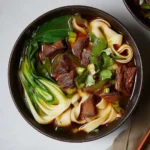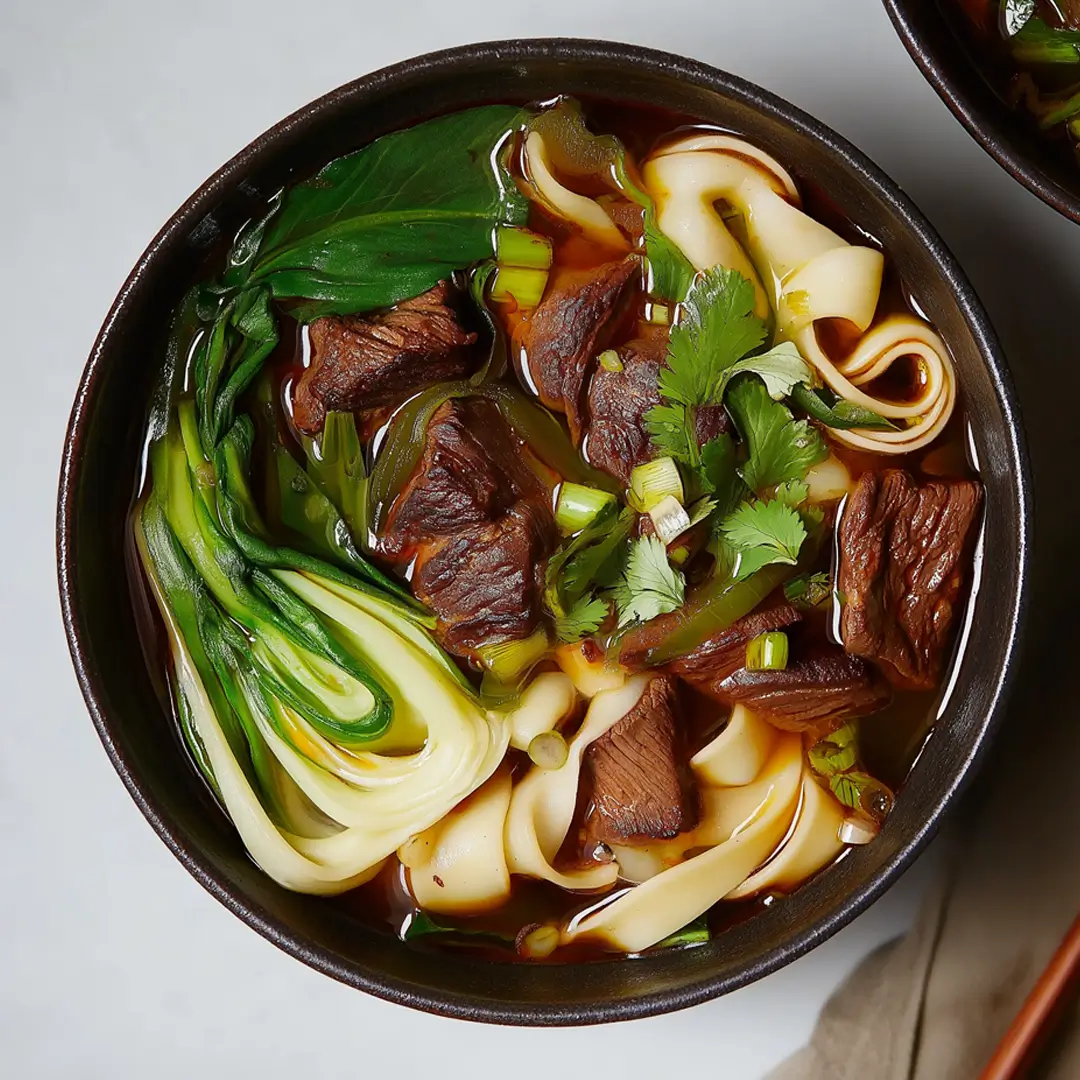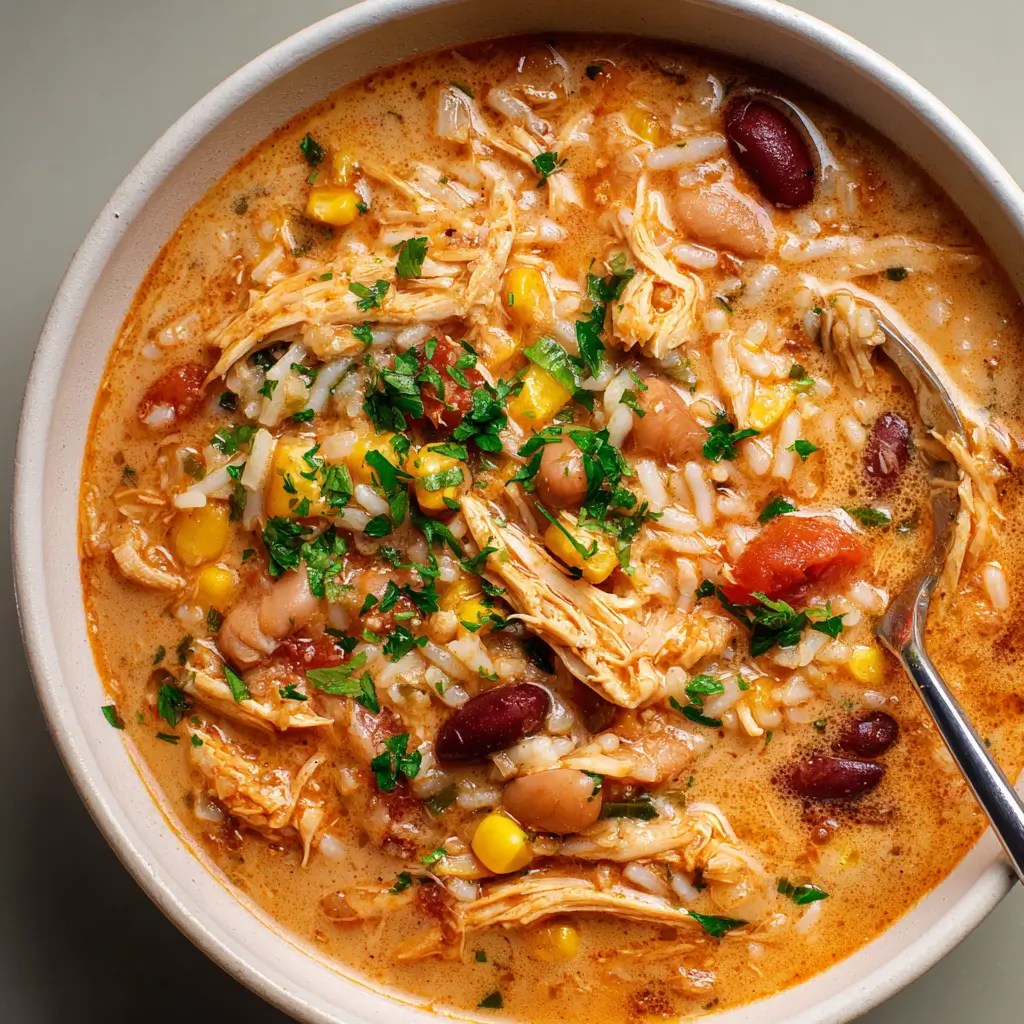Braised beef noodle soup is a classic East Asian dish known for its rich broth, tender chunks of beef, and perfectly chewy noodles. It’s often simmered with aromatics like ginger, garlic, and star anise, which give the broth its deep, signature flavor. Traditionally served as a complete meal in one bowl, it’s hearty, satisfying, and easy to customize based on your taste or what you have on hand.
At its core, this dish is all about comfort not in a heavy way, but in that warm, steady kind of way that makes you feel like you’ve eaten something genuinely nourishing. The beef is slowly braised until soft, the noodles soak up all that flavor, and the toppings bring everything together with freshness and texture.
What I liked most about making braised beef noodle soup at home was how straightforward the process turned out to be. Once you understand the timing and layering of flavors, it becomes second nature. I especially appreciated the flexibility I could adjust the saltiness, add more greens, or tweak the spices depending on what I was craving.
This version strikes a balance between traditional methods and small adjustments I’ve learned over time to make the process smoother. If you’re looking for a reliable, deeply flavorful bowl of noodle soup that doesn’t rely on shortcuts but doesn’t feel overly complicated either, this is a great place to start.
Key Ingredients
When it comes to braised beef noodle soup, the magic lies in selecting the right ingredients. Each component plays a role in building deep, layered flavor the kind that makes this dish so iconic across East Asian kitchens.
Core Ingredients
Beef Shank or Chuck:
Start with a well-marbled cut like beef shank or chuck. These cuts break down beautifully during slow braising, yielding tender, juicy bites. Shank adds extra richness thanks to the bone marrow, while chuck offers excellent flavor with a bit more meat.
Soy Sauce (Light and Dark):
A blend of both light and dark soy sauces adds complexity light soy brings saltiness, while dark soy contributes depth and color.
Aromatics:
Ginger, garlic, scallions, and star anise are non-negotiable. They lay down the aromatic foundation that defines the broth’s warm, fragrant notes.
Rock Sugar and Shaoxing Substitutes:
Skip the wine instead, rock sugar balances the savoriness with subtle sweetness. You can substitute with brown sugar in a pinch.
Beef Broth or Water:
A rich homemade beef broth is ideal, but water with the right aromatics still delivers.
Noodles:
Wheat noodles are traditional. Choose ones with a bit of chew they hold up better in hot broth without getting soggy.
Optional Additions
Want to customize your bowl? Add bok choy or napa cabbage for crunch and freshness. Chili oil introduces heat, while pickled mustard greens bring brightness. Some love adding daikon radish for sweetness or shiitake mushrooms for umami. And let’s not forget soy-marinated eggs simple, but unbeatable.
How to Make Braised Beef Noodle Soup
Making braised beef noodle soup might seem intimidating at first, but once you break it down, it’s surprisingly straightforward. It’s all about slow, intentional cooking — letting time and heat do the heavy lifting.
Step 1: Prepare the Beef
Start by blanching the beef. Place it in boiling water for 3–5 minutes to remove impurities. This step ensures a cleaner broth. Then, rinse the beef and cut it into large chunks. Bigger pieces mean better texture after long cooking.
Step 2: Sear the Aromatics
In a heavy-bottomed pot, heat a splash of neutral oil. Toss in sliced ginger, smashed garlic, scallions, and star anise. Let them sizzle until fragrant. This toasting step boosts aroma and pulls out deep flavors.
Step 3: Braise the Beef
Return the beef to the pot. Add light and dark soy sauce, rock sugar, and a bit of five-spice powder if you like. Pour in just enough water or beef broth to cover the meat. Bring to a boil, then drop the heat to a low simmer. Cover and braise for 90 minutes to 2 hours or until the beef is fork-tender.
Step 4: Cook the Noodles
Boil your noodles separately according to package instructions. Rinse them briefly in cold water after cooking to keep them springy. This step prevents them from overcooking when added to hot broth later.
Step 5: Assemble and Serve
Place noodles in a bowl. Ladle over that rich, beefy broth. Add chunks of braised beef, then top with greens, chili oil, scallions, or your favorite garnish.
My Best Braised Beef Noodle Soup Tips
After making braised beef noodle soup more times than I can count, I’ve picked up a few tricks that really make a difference and I’m not talking about textbook advice. These are the tips that actually save time, deepen flavor, and improve consistency in real kitchens.
Use the Right Cut for Long Braises
Don’t use lean cuts they’ll dry out or turn tough. Stick to well-marbled options like beef shank or chuck. These cuts become buttery soft after simmering low and slow. Shank, in particular, adds bonus richness if you keep the bone in.
Toast Your Spices First
It’s tempting to throw everything into the pot and call it a day, but pausing to toast your aromatics and spices especially star anise, five-spice powder, and scallions brings out a deeper, rounder flavor. That little browning step at the start pays off big later.
Don’t Skip the Blanching
Blanching the beef before braising isn’t just for looks. It removes impurities that would otherwise cloud your broth and add off-flavors. It’s a small step that elevates the final bowl tremendously.
Simmer, Don’t Boil
Too much heat can toughen the beef and mute your aromatics. Keep the pot barely bubbling. It should look more like a gentle stew than a rolling boil.
Balance the Flavor Before Serving
Before you serve, give the broth a final taste. A splash more soy sauce, a pinch of sugar, or even a dash of vinegar can fine-tune the balance depending on your palate.
Variations of Braised Beef Noodle Soup
One of the best things about braised beef noodle soup is how flexible it is. Different regions and even different households put their own spin on it. Once you’ve mastered the basics, experimenting with variations is a fun way to keep things exciting without reinventing the wheel.
Taiwanese-Style Braised Beef Noodle Soup
Arguably the most famous version outside of China, the Taiwanese style features a deep, dark soy-based broth. It’s often slightly sweet, thanks to the rock sugar, and layered with notes of cinnamon and star anise. Pickled mustard greens and chili oil are common toppings that add a punch of tangy heat.
Sichuan Spicy Beef Noodle Soup
Love a fiery kick? Try Sichuan-style. This variation uses doubanjiang (chili bean paste) to bring depth and heat, along with Sichuan peppercorns for that signature tingling sensation. It’s bold, spicy, and perfect for cold nights.
Hong Kong Clear Broth Version
Prefer something lighter? The Hong Kong style uses a clearer broth, often based on beef bones and minimal soy sauce. It’s subtly sweet, less oily, and focuses on the natural flavor of the beef and broth. Great if you want a less intense bowl.
Vegetable-Heavy Take
Add bok choy, napa cabbage, carrots, and daikon radish for a broth that leans more toward wellness. While it may not be traditional, it’s a great way to add freshness and color without losing the dish’s heart.
For more delicious recipes, check out our comfort-food classic: beef barley soup in the Instant Pot. It’s another warming bowl that’s perfect for colder days.
Common Mistakes & Fixes
Even with the best intentions, braised beef noodle soup can go sideways if you’re not careful. Luckily, most common problems are easy to fix and even easier to avoid once you know what to watch for.
Overcooking or Undercooking the Beef
Tough beef usually means one of two things: you cooked it too fast, or you didn’t give it enough time. A rolling boil will tighten the meat, while too short a braise leaves it chewy. The fix? Cook low and slow, and always check for doneness with a fork it should glide in easily.
Cloudy or Bitter Broth
Skipping the blanching step or burning your aromatics can leave your broth cloudy or bitter. Don’t rush the prep. Blanch the beef, toast the aromatics gently, and simmer never boil your broth.
Soggy Noodles
Cooking the noodles directly in the broth might seem easier, but it’s a mistake. They’ll turn mushy fast and soak up too much of your hard-earned broth. Always cook noodles separately and add them to each bowl right before serving.
Flat Flavor
A weak broth can kill the entire experience. This is usually from under-seasoning or not giving the spices time to infuse. Remember to taste, adjust, and don’t be afraid of a little rock sugar or extra soy sauce near the end.
FAQs About Braised Beef Noodle Soup
Over the years, I’ve received all sorts of questions about making braised beef noodle soup at home. Whether it’s about health, beef cuts, or technique, here are the most common ones answered with real-world clarity.
Is braised beef noodle soup healthy?
Yes, it can absolutely be a healthy option especially when made at home. Since you’re in control of the ingredients, you can keep the sodium in check, skip processed add-ons, and load it up with vegetables like bok choy or daikon radish. Choose lean cuts of beef and go easy on the oil for a lighter version. The result? A warming bowl that nourishes without weighing you down.
How to braise beef for soup?
Start by searing your beef to lock in flavor. Then simmer it gently in a mixture of soy sauce, aromatics (like garlic, ginger, and scallions), and enough broth to just cover the meat. The key here is low and slow it usually takes around 90 minutes to two hours. The result? Beef so tender it practically melts.
What is the best beef for beef noodle soup?
Hands down, beef shank and chuck are your best bets. They both offer the perfect balance of meat and connective tissue, which breaks down during braising to create that ultra-satisfying texture. Avoid lean cuts they won’t hold up to the long cooking time.
What’s the difference between braised beef and stew beef?
Braised beef is typically cooked in less liquid and focuses on deeply flavored sauces or broths. Stew beef, by contrast, is often submerged and includes more veggies. Think of braising as the more concentrated, flavor-packed cousin of stewing.
Print
Braised Beef Noodle Soup
- Total Time: 2 hours 15 minutes
- Yield: 4 servings 1x
Description
Braised Beef Noodle Soup is a flavorful and comforting dish that combines tender beef, aromatic spices, and chewy noodles in a rich, spicy broth. This recipe brings the authentic taste of Sichuan cuisine to your kitchen, offering a hearty meal perfect for any occasion.
Ingredients
For the Braised Beef and Broth
500 g beef soup meat
2 tablespoons vegetable oil
5 slices ginger
1 scallion, chopped
2 star anise pods
2 bay leaves
1 cinnamon stick
2 tablespoons fennel seeds
2 dried chilies
5 Sichuan peppercorns
10 g sugar
1 tablespoon doubanjiang (Sichuan chili bean paste)
3 tablespoons light soy sauce
1 tablespoon dark soy sauce
500 ml beef stock
200 ml water
For Assembly:
300 g Asian wheat noodles
4 heads bok choy, halved
10 g cilantro, chopped
Instructions
-
Prepare the Beef:
Cut the beef into large chunks. In a pot of boiling water, blanch the beef for 3–5 minutes to remove impurities. Drain and set aside. -
Sauté Aromatics:
Heat vegetable oil in a large pot over medium heat. Add ginger slices, chopped scallion, star anise, bay leaves, cinnamon stick, fennel seeds, dried chilies, and Sichuan peppercorns. Sauté until fragrant, about 2 minutes. -
Caramelize Sugar and Add Doubanjiang:
Add sugar to the pot and stir until it melts and caramelizes. Stir in the doubanjiang and cook for another minute to release its flavors. -
Braise the Beef:
Return the blanched beef to the pot, stirring to coat with the aromatic mixture. Add light soy sauce and dark soy sauce, mixing well. Pour in the beef stock and water, ensuring the beef is submerged. Bring to a boil, then reduce heat to low. Cover and simmer for 1.5 to 2 hours, or until the beef is tender. -
Cook the Noodles and Bok Choy:
About 10 minutes before the beef is ready, cook the Asian wheat noodles according to package instructions. In the last minute of cooking, add the bok choy to blanch. Drain and set aside. -
Assemble the Soup:
Divide the cooked noodles and bok choy among serving bowls. Ladle the braised beef and broth over the noodles. Garnish with chopped cilantro.
Notes
- Doubanjiang:
This fermented chili bean paste is essential for authentic Sichuan flavor. Adjust the amount to control the spice level. -
Beef Selection:
Opt for cuts like beef shank or chuck, which become tender and flavorful after slow braising. -
Noodle Choice:
Use Asian wheat noodles that are firm and chewy to hold up well in the broth. -
Adjusting Spice Levels:
For a spicier soup, increase the number of dried chilies and Sichuan peppercorns. -
Storage Tips:
The braised beef and broth can be refrigerated for up to 3 days. Reheat gently before serving.
- Prep Time: 15 minutes
- Cook Time: 2 hours
- Category: Dinner
- Method: Braising
- Cuisine: Sichuan
Nutrition
- Serving Size: 1 bowl
- Calories: 500 kcal
- Sugar: 5g
- Sodium: 900mg
- Fat: 20g
- Carbohydrates: 50g
- Fiber: 3g
- Protein: 35g
- Cholesterol: 80mg
Keywords: braised beef noodle soup



